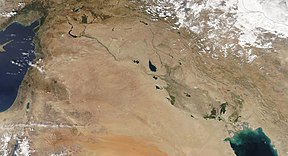
Back Аҩӡыбжьара AB Mesopotamië AF Mesopotamien ALS መስጴጦምያ AM Mesopotamia AN بلاد الرافدين Arabic ܒܝܬ ܢܗܪܝܢ ARC منطقة بين النهرين ARZ মেচ'পটেমিয়া AS Mesopotamia AST
| History of Iraq |
|---|
 |
|
|
Mesopotamia[a] is a historical region of West Asia situated within the Tigris–Euphrates river system, in the northern part of the Fertile Crescent. Today, Mesopotamia is known as present-day Iraq.[1][2] In the broader sense, the historical region of Mesopotamia also includes parts of present-day Iran, Turkey, Syria and Kuwait.[3][4]
Mesopotamia is the site of the earliest developments of the Neolithic Revolution from around 10,000 BC. It has been identified as having "inspired some of the most important developments in human history, including the invention of the wheel, the planting of the first cereal crops, the development of cursive script, mathematics, astronomy, and agriculture". It is recognised as the cradle of some of the world's earliest civilizations.[5]
The Sumerians and Akkadians, each originating from different areas, dominated Mesopotamia from the beginning of recorded history (c. 3100 BC) to the fall of Babylon in 539 BC. The rise of empires, beginning with Sargon of Akkad around 2350 BC, characterized the subsequent 2,000 years of Mesopotamian history, marked by the succession of kingdoms and empires such as the Akkadian Empire. The early second millennium BC saw the polarization of Mesopotamian society into Assyria in the north and Babylonia in the south. From 900 to 612 BC, the Neo-Assyrian Empire asserted control over much of the ancient Near East. Subsequently, the Babylonians, who had long been overshadowed by Assyria, seized power, dominating the region for a century as the final independent Mesopotamian realm until the modern era.[6] In 539 BC, Mesopotamia was conquered by the Achaemenid Empire. The area was next conquered by Alexander the Great in 332 BC. After his death, it became part of the Greek Seleucid Empire.
Around 150 BC, Mesopotamia was under the control of the Parthian Empire. It became a battleground between the Romans and Parthians, with western parts of the region coming under ephemeral Roman control. In 226 AD, the eastern regions of Mesopotamia fell to the Sassanid Persians. The division of the region between the Roman Byzantine Empire from 395 AD and the Sassanid Empire lasted until the 7th century Muslim conquest of Persia of the Sasanian Empire and the Muslim conquest of the Levant from the Byzantines. A number of primarily neo-Assyrian and Christian native Mesopotamian states existed between the 1st century BC and 3rd century AD, including Adiabene, Osroene, and Hatra.
Cite error: There are <ref group=lower-alpha> tags or {{efn}} templates on this page, but the references will not show without a {{reflist|group=lower-alpha}} template or {{notelist}} template (see the help page).
- ^ Seymour, Michael (2004). "Ancient Mesopotamia and Modern Iraq in the British Press, 1980–2003". Current Anthropology. 45 (3): 351–368. doi:10.1086/383004. ISSN 0011-3204. JSTOR 10.1086/383004. S2CID 224788984. Archived from the original on 30 April 2022. Retrieved 30 April 2022.
- ^ Cite error: The named reference
miqueletalwas invoked but never defined (see the help page). - ^ Sissakian, Varoujan K.; Adamo, Nasrat; Al-Ansari, Nadhir; Mukhalad, Talal; Laue, Jan (January 2020). "Sea Level Changes in the Mesopotamian Plain and Limits of the Arabian Gulf: A Critical Review". Journal of Earth Sciences and Geotechnical Engineering. 10 (4): 88–110.
- ^ Pollock, Susan (1999), Ancient Mesopotamia. The Eden that never was, Case Studies in Early Societies, Cambridge: Cambridge University Press, p. 1, ISBN 978-0-521-57568-3
- ^ Milton-Edwards, Beverley (May 2003). "Iraq, past, present and future: a thoroughly-modern mandate?". History & Policy. United Kingdom. Archived from the original on 8 December 2010. Retrieved 9 December 2010.
- ^ Lemche, Niels Peter (2004). "Assyria and Babylonia". Historical dictionary of ancient Israel. Historical dictionaries of ancient civilizations and historical eras. Lanham, Md.: Scarecrow Press. pp. 64–67. ISBN 978-0-8108-4848-1.

